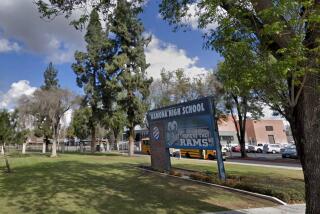Much of L.A. Airspace Remains Restricted
News helicopters are back in the air, but those high-speed car chases and brush fires may have to occur in the San Fernando Valley or eastern Los Angeles and southern Orange counties to get any coverage.
It’s just one of the many effects--some social, some economic--of lingering flight restrictions.
Although the Federal Aviation Administration has eased some restrictions on flying, it is still roping off much of the airspace above the Los Angeles area and 29 other cities with major airports. These restrictions apply to general aviation pilots who are not instrument rated and thus cannot fly under full FAA control.
The ban has been lifted for instrument-rated pilots. In Southern California, they can get permission to enter the restricted swath of airspace from Malibu to the Hollywood Hills and out to Walnut and down to Newport Beach. But they must give a specific route and destination, which effectively eliminates traffic and news helicopters even if the pilot is instrument rated.
FAA administrators have taken a zone designed to protect flights in and out of Los Angeles International Airport and enhanced it in the wake of the terrorist attacks.
Before, most small planes and helicopters using visual flight rules flew below or above the restricted airspace, known as Class B airspace. Not now.
Jerry Snyder, an FAA spokesman, described the restricted space above LAX as “a pillar 25 miles in diameter.”
Outside this area, however, such aircraft can fly as they have in the past--and trail car chases if they want to.
Snyder said the restrictions are continuing because of “security concerns” after the attacks on the Pentagon and World Trade Center.
The restrictions are tying up movie makers and news helicopters, but operators said they are relieved to have a least some access to airspace once more.
“We are glad to be back in the air,” said Kevin LaRosa, president of Jetcopters, a Van Nuys-based company that leases helicopters and planes to news media. “But the restricted area is a pretty big chunk of real estate. . . .”
The new rules have left runways empty and hangars crowded at various municipal airports that fall within the restricted airspace, such as Santa Monica, Torrance, Hawthorne, Long Beach, Compton and Fullerton, officials said.
“It’s pretty darn quiet at all the airports within the enhanced Class B airspace,” said Robert Triborn, manager of the Santa Monica Airport. “We’re operating at about 40% to 50% of our normal traffic. This area is known for its general aviation activity and there are a lot of aircraft sitting on the ground.”
At Fullerton Municipal Airport, where flights are down 80% as a result of the ban, financial losses are mounting. All three of the airport’s fixed-base operators--companies that fly small aircraft out of the facility--have asked the city, which owns the airport, for financial relief.
“They can’t pay their rent if they’re not generating income,” said Rod Propst, airport manager.
The president of the Aircraft Owners and Pilot Assn., Phil Boyer, on Monday urged his 375,000 members to call their congressional representatives today for some relief.
The association wants a meeting between the National Security Council and general aviation organizations to discuss procedures that will allow reasonable access to Class B airspace under visual flight rules--while addressing security concerns.
“Something must be done immediately to permit these 41,000 general aviation aircraft to return to the skies,” Boyer said of the small aircraft in the 30 restricted areas. Restrictions in Washington and New York, he said, have been particularly harmful to business. “Their property has effectively been confiscated by the federal government,” he said.
Richard Voorhis, president of the Van Nuys Flight Center, described the situation this way: “All in the name of national security, we’re destroying the aviation industry.”
Adding to the troubles for pilots, the FAA, citing national security, has advised pilots to avoid the airspace above or near nuclear power plants, power plants, dams and oil refineries.
Voorhis also complained that the flight restrictions allow a “ridiculous” exemption. Student pilots are still allowed to fly in Class B airspace, either with their instructors with them or even on the ground.
Times staff writer David Haldane contributed to this story.
More to Read
Sign up for Essential California
The most important California stories and recommendations in your inbox every morning.
You may occasionally receive promotional content from the Los Angeles Times.











